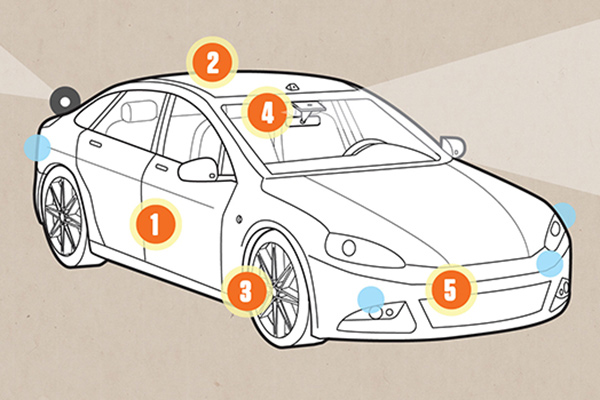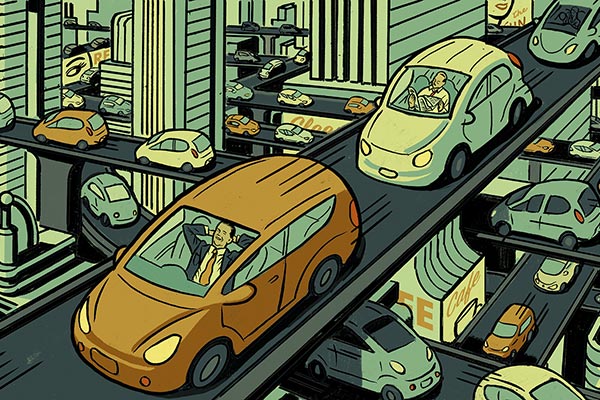Autonomous cars are already a reality—at least, they are in Phoenix, Ariz., where an autonomous vehicle company has partnered with a rideshare service. Its cars are already picking up and depositing riders—all without a human driver at the wheel.
While this has been a limited-scale project—in a city with normally good weather—being chauffeured around without a chauffeur is closer to becoming a common occurrence. The National Highway Traffic Safety Administration says that fully automated cars and trucks are on their way, 29 states have enacted legislation for allowing autonomous vehicles on their roads, and the U.S. Department of Transportation (DOT) recently announced plans to ease federal regulations surrounding autonomous vehicles.
The DOT’s rationale? Safety. As much as 94 percent of all serious automobile crashes are attributed to human error. Unlike human drivers, autonomous vehicles are not prone to distraction, fatigue or impaired driving.
So why aren’t we all buzzing around town in driverless vehicles? Why is it taking so long?
The Obstacles For Self-Driving Cars
There several issues that still need to be ironed out, say experts.
Weather
Just like a human driver, weather affects a driverless vehicle, says Melba Kurman, co-author of Driverless. If we can’t see in the fog, a camera can’t see in the fog, either—even an advanced camera that performs 360-degree scans up to 20 times per second and has deep-learning software to “teach” it to recognize objects.
However, that’s just one of the tools that autonomous vehicles use to “see.” There’s also LiDAR (light detection and ranging)—a sensing system that uses a spinning laser beam and calculates how long it takes for light to hit and then reflect back from an object. Cars also use radar, which measures radio waves to detect an object’s bearing, range and velocity.
Possible solution: Whether it’s LiDAR or better cameras that are used as the primary visual sensor, says Kurman, they are all feeding data into neural deep-learning networks and making autonomous driving systems smarter and better. “When companies are ready to invest in training driverless vehicles to handle snowy or foggy road conditions,” she says, “the cars’ performance will exceed that of a human driver.”
Liability & Insurance
This will be tricky, Kurman says, because if no one’s driving, who’s at fault if there’s an accident?
Possible solution: Policies and regulations will have to change to support the new technology—but they will, says Kurman. “Government and insurance companies will figure it out—after all, they’ve adapted to new technologies in the past.”
Non-standardized Road Markings
Signs and lights can vary by state—or even by municipality. Some traffic signals are horizontal, for example, while others are vertical. Plus, signs that mark the miles or exits along the highway aren’t the same from state to state, and if they’re damaged or old, they could be tough to read. If the car hasn’t learned all of the variables, there could be safety ramifications.
Possible solution: With artificial intelligence (AI) technology, computer-run vehicles are increasingly capable of learning at a rate far faster than humans. Eventually, cars will become smart enough that these variations won’t matter, says Paul Godsmark, chief technology officer of CAVCOE (formerly the Canadian Automated Vehicles Centre of Excellence), an Ontario-based nonprofit.
Recognition Of Objects
Road signs are one thing. But distinguishing between, say, a cat and a cardboard box—or a child and a small tree—can be tricky, and Godsmark says that companies are still working out kinks in image identification and classification.
Possible solution: With continued training, AI is getting better and better at recognizing objects—and is already better than humans in some circumstances, Godsmark says. AI is developing at an exponential rate, and any image-class problem that exists today might not be a problem in the near future.
Potential For Hacking
The cars’ computerized systems and the network of vehicles means that a security breach could have serious consequences. “When I go through things that would keep me up at night, this is at the top of the list,” Godsmark says.
Possible solution: “It gives me comfort,” Godsmark says, “that the tech companies leading autonomous-vehicle technology are world leaders in cyber security.”
Adoption Hesitancy
The handful of accidents involving autonomous vehicles have received lots of media attention; this could make people hesitant or unwilling to embrace autonomous vehicles.
Possible solution: If, say, 75 percent of people are unwilling to ride in a driverless vehicle, that’s good news, says Godsmark, because it means that 25 percent already are. “It’s a new technology and people are bound to be skeptical,” he says. “But once people try it, they’ll be won over.”
The Benefits Of Self-Driving Cars
Once the obstacles are overcome, these will be some of the benefits.
- Greater safety, less congestion. Driverless cars mean potentially fewer accidents, which can cause traffic backups.
- Environmentally beneficial. Autonomous vehicles will likely be smaller and electric-charged, rather than outfitted with fossil-fuel engines.
- Enhanced productivity. While you’re being driven to your destination, you can catch up on email and work calls—or do neither and take a nap.
- Greater independence. Older people and those with mobility issues will be able to remain self-sufficient by being able to easily travel to places like the grocery store, the movies or a restaurant.
Self-Driving Cars: How They Work
 You climb into your car, punch your destination into the GPS…and then curl up under a blanket for a nice nap while your vehicle drives itself there.
You climb into your car, punch your destination into the GPS…and then curl up under a blanket for a nice nap while your vehicle drives itself there.
Sound like a dream? Not quite.
With several manufacturers now developing technology for self-driving cars, many advancements are expected in the next few years. In fact, some experts have predicted that in our lifetime, we could be living in a world in which most cars on the roads will be driverless.
The basic components of self-driving cars already exist—they just need to be refined. Here’s a look at how most autonomous vehicles are wired.
1. Onboard Computer
Uses a neural network to process LIDAR and radar inputs.
2. Global Positioning System
GPS signals are combined with measurements from onboard meters for advanced location accuracy.
3. LIDAR Sensors
LIDAR (light detection and ranging) uses pulses of light to map nearby cars and objects
4. Hi-Def Cameras
Provide wide-range visibility to detect and identify traffic lights and road signs.
5. Forward-Facing Radar
Can detect other cars through inclement weather.
Wherever automotive technology goes, we’ll be there with solutions and savings. Speaking of which, now’s a great time to get a quote on auto insurance from GEICO and see if you could save!
Read more: 5 Hi-Tech Safety Features To Look For In A New Car
By Ellise Pierce and Mark Yarm










Vivian L Stanley says,
We are NOT all driving self driving cars because we are ALL NOT IDIOTS who need things done for them……
G. Quarles says,
Take it easy. It’s going to happen whether we like it or not. The name of the game, so to speak, is adaptability.
Constance Mccormick says,
Defensive Driving in Heavy Traffic
Krishna Harish says,
I am going to make them a reality…